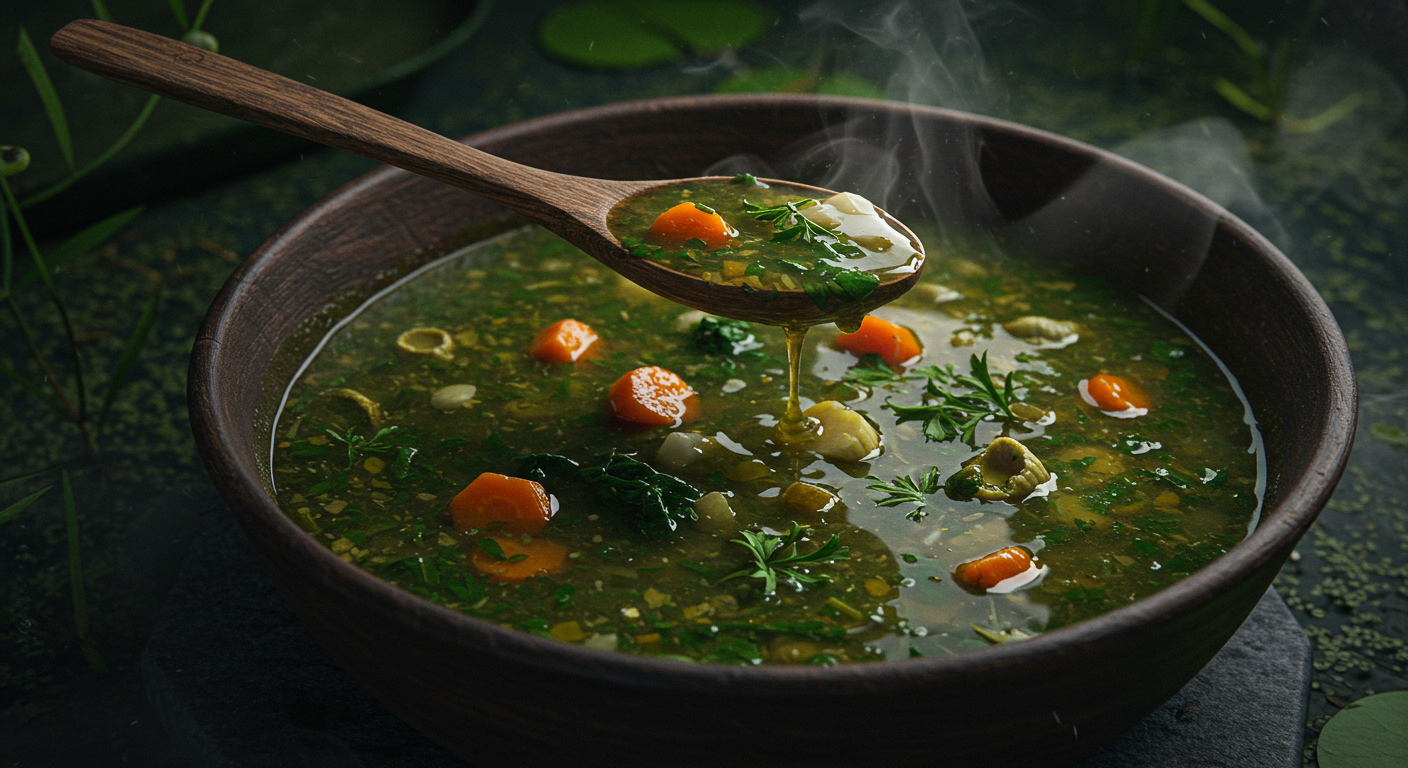The Comforting Magic of Swamp Soup
Some days all you want is a meal that can fill you up and warm you. That’s where the swamp soup recipe comes in—a dish that’s as hearty as it is flavorful. Whether you’ve had a long, cold day or simply want something delicious to share with friends and family, swamp soup is the answer. This comforting, vegetable-packed soup is simple to prepare and ideal for anyone seeking a satisfying meal that satisfies all their cravings.
With its rich flavors and hearty ingredients, this recipe is the kind of comfort food you can count on. Whether you’re a seasoned cook or a beginner, this swamp soup recipe will soon become your go-to for those cozy, satisfying meals. Let’s dive into how to make it, step by step!
Table of Contents
What Is Swamp Soup?
Before we jump into the swamp soup recipe, let’s talk about what makes this dish unique. Swamp soup is a thick, hearty soup known for its vibrant, green color, often due to the generous use of leafy greens like kale or spinach. Its name might sound a bit quirky, but it reflects the rich, earthy quality of the soup, often evoking the depth of swampy, lush landscapes.
The beauty of swamp soup is in its simplicity. It’s an easy, comforting meal that’s packed with healthy vegetables, flavorful herbs, and a hearty broth. The soup typically combines greens like kale or spinach, potatoes, and other vegetables, all simmered together to create a filling, wholesome dish that’s perfect for chilly evenings.
Key Ingredients for the Best Swamp Soup Recipe
Now that you know a bit about swamp soup, let’s talk about the ingredients that will bring this recipe to life. The beauty of swamp soup lies in its versatility, but there are a few key ingredients that define it. Here’s a list of the essential ingredients you’ll need:
Table of Ingredients
| Ingredient | Amount | Notes/Alternatives |
|---|---|---|
| Onion | 1 medium | Yellow or white onion works best |
| Celery | 2 stalks | Can be substituted with leeks |
| Spinach or Kale | 3 cups | For the signature “swampy” green color |
| Potatoes | 2 medium | Sweet potatoes work well, too |
| Garlic | 4 cloves | Minced for added depth of flavor |
| Chicken Broth | 4 cups | Use vegetable broth for a vegan version |
| Seasoning | To taste | Thyme, bay leaves, salt, pepper |
These ingredients are the backbone of your swamp soup recipe. The onions and garlic provide an aromatic base, while the vegetables contribute texture and flavor. The greens not only add that swampy color but also bring a ton of nutrients to the dish, making it a great source of vitamins and minerals.
Ingredient Substitutions
If you’re looking to switch things up based on your dietary needs or preferences, you have plenty of options. For example:

- For a vegan version, simply swap the chicken broth for vegetable broth, and opt for plant-based protein sources like beans or lentils instead of any meat.
- For a heartier soup, you can add some sausage or bacon for extra flavor, or toss in a can of white beans for a protein-packed vegetarian version.
How to Make Swamp Soup: Step-by-Step
Now, let’s get to the fun part: making your very own swamp soup. This swamp soup recipe is designed to be straightforward and easy to follow, even for those new to cooking. Here’s how to prepare this comfort food:
Step 1: Prepare the Ingredients
Start by chopping the vegetables. Mince the garlic and chop the onion and celery. Peel and cube the potatoes, and make sure to wash your greens thoroughly before chopping them into bite-sized pieces.
Step 2: Sauté the Vegetables
Melt a tablespoon of olive oil in a large saucepan over medium heat. Add the onions, celery, and garlic. Sauté for about 5 minutes or until the vegetables have softened and the kitchen smells heavenly.
Step 3: Add the Broth and Bring to a Simmer
Once your vegetables are sautéed, pour in the chicken or vegetable broth. Stir everything together, scraping away any browned bits at the bottom of the pot. Bring the mixture to a moderate simmer on medium heat.
Step 4: Add the Potatoes and Greens
Next, add the cubed potatoes and your chopped greens. Stir everything together and let the soup simmer for 20-30 minutes, or until the potatoes are tender and the flavors have melded together.
Step 5: Season and Serve
Season your swamp soup with salt, pepper, thyme, and bay leaves to taste. Once everything is perfectly seasoned, ladle the soup into bowls and serve hot. For extra comfort, top your soup with a dollop of sour cream or a sprinkle of cheese.
Tips for Perfecting Your Swamp Soup Recipe
While this swamp soup recipe is pretty straightforward, there are a few tips and tricks that can help you elevate the dish and make it even more delicious. Here are some expert tips:
Adjust the Texture
If you prefer a creamier texture, you can use an immersion blender to blend a portion of the soup once the potatoes are soft. This will give you a smooth, velvety base while still keeping some of the vegetable chunks intact.
Make It Heartier
Want to make this soup even more filling? Add some protein. You can toss in cooked sausage, shredded chicken, or even beans for an extra punch of nutrition. This is especially great if you’re feeding a large group or looking to make it a more substantial meal.
Spice Things Up
If you like a little heat, consider adding some cayenne pepper or red pepper flakes to the soup while it simmers. A splash of hot sauce or a sprinkle of paprika can also give your swamp soup an extra layer of depth.
Why Swamp Soup is the Ultimate Comfort Food
You might be wondering: What makes swamp soup so special? Well, it’s all about the flavors. Swamp soup is not only comforting and hearty but also packed with healthy vegetables, making it a nourishing choice for those cold evenings when you need a little TLC.
The soup’s richness comes from its blend of fresh vegetables, tender potatoes, and flavorful broth, which is why it’s the ultimate comfort food. Plus, it’s incredibly versatile—whether you’re craving something light and fresh or a filling, protein-packed meal, swamp soup has you covered.
Storing and Reheating Leftover Swamp Soup
One of the best things about swamp soup is that it keeps really well. In fact, like most soups, it often tastes even better the next day as the flavors continue to develop. The best way to keep and reheat leftovers is as follows:
Fridge Storage
Allow your soup to cool to room temperature before transferring it to an airtight container. Put it in the fridge and it will keep for three days. You can store it in the fridge for up to 3 days. Just reheat it on the stove over low heat until it’s warmed through.
Freezing Swamp Soup
If you want to make a big batch and freeze some for later, swamp soup freezes beautifully. Store it in freezer-safe containers or zip-top bags, and it will keep for up to 3 months. When you’re ready to eat, simply thaw it overnight in the fridge and reheat on the stove.
FAQs About Swamp Soup
What is the best way to thicken swamp soup?
If you find that your swamp soup is too thin, there are a few ways to thicken it:
- Use a potato masher to mash some of the potatoes into the broth.
- Blend part of the soup with an immersion blender to create a thicker base.
Can I cook swamp soup in a slow cooker?
Absolutely! To make swamp soup in a slow cooker, sauté the vegetables as usual, then transfer them to your slow cooker with the broth and seasonings. Cook on low for 6 to 8 hours, or until the potatoes are soft.
Can I use frozen greens rather than fresh ones?
Yes, you can use frozen spinach or kale in this swamp soup recipe. Just make sure to thaw and drain the greens before adding them to the soup to avoid excess water.
Conclusion: Enjoy Your Swamp Soup Creation!
Congratulations! You’ve just made a delicious swamp soup recipe that’s as comforting as it is nutritious. With its rich flavors, hearty ingredients, and endless customization options, swamp soup is sure to become a staple in your kitchen. Whether you’re making it for a family dinner or prepping meals for the week, it’s a recipe you’ll come back to time and time again.
Now that you’ve mastered the swamp soup recipe, why not share your thoughts or any variations you’ve tried in the comments below? We’d love to hear from you!

